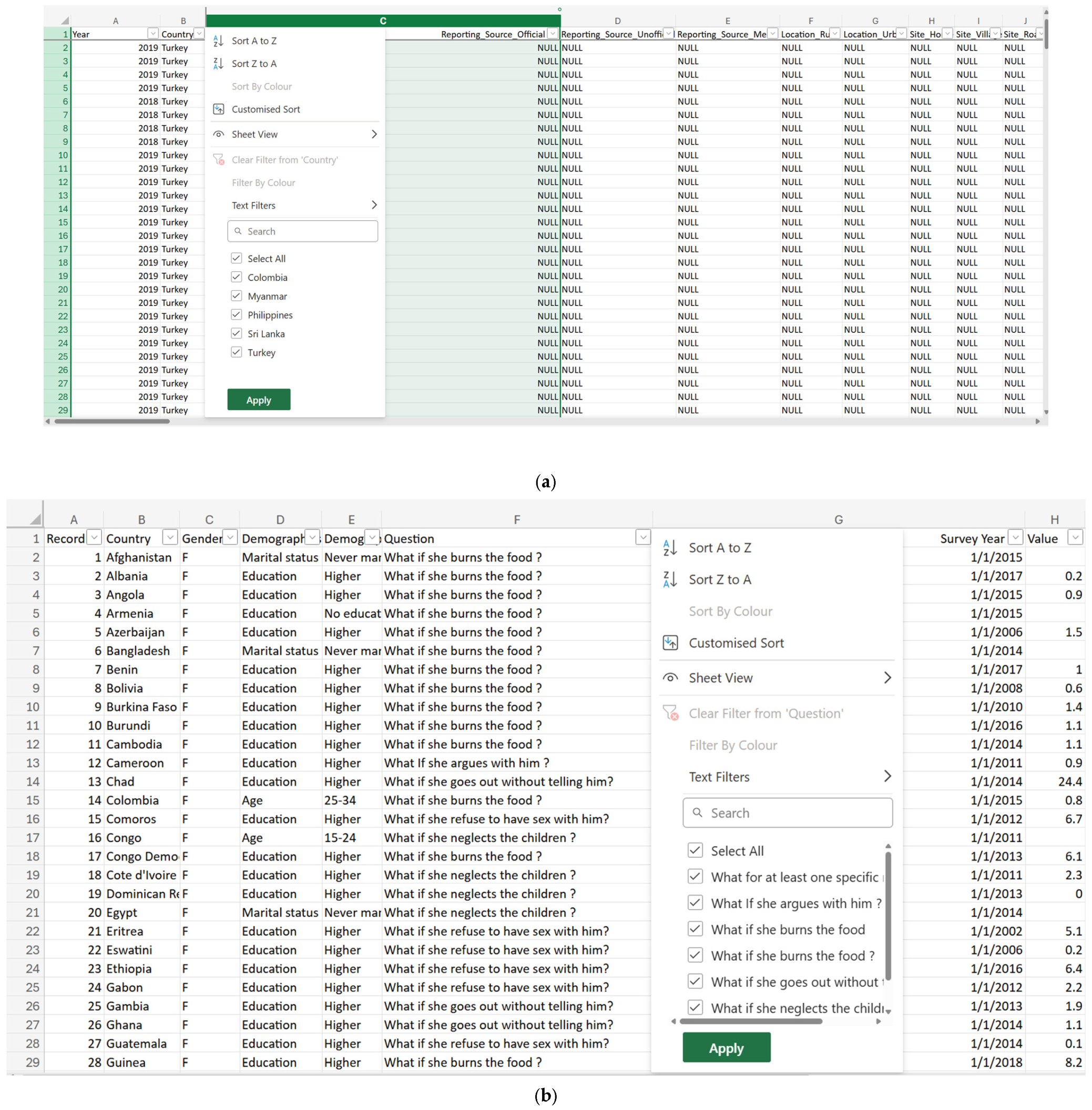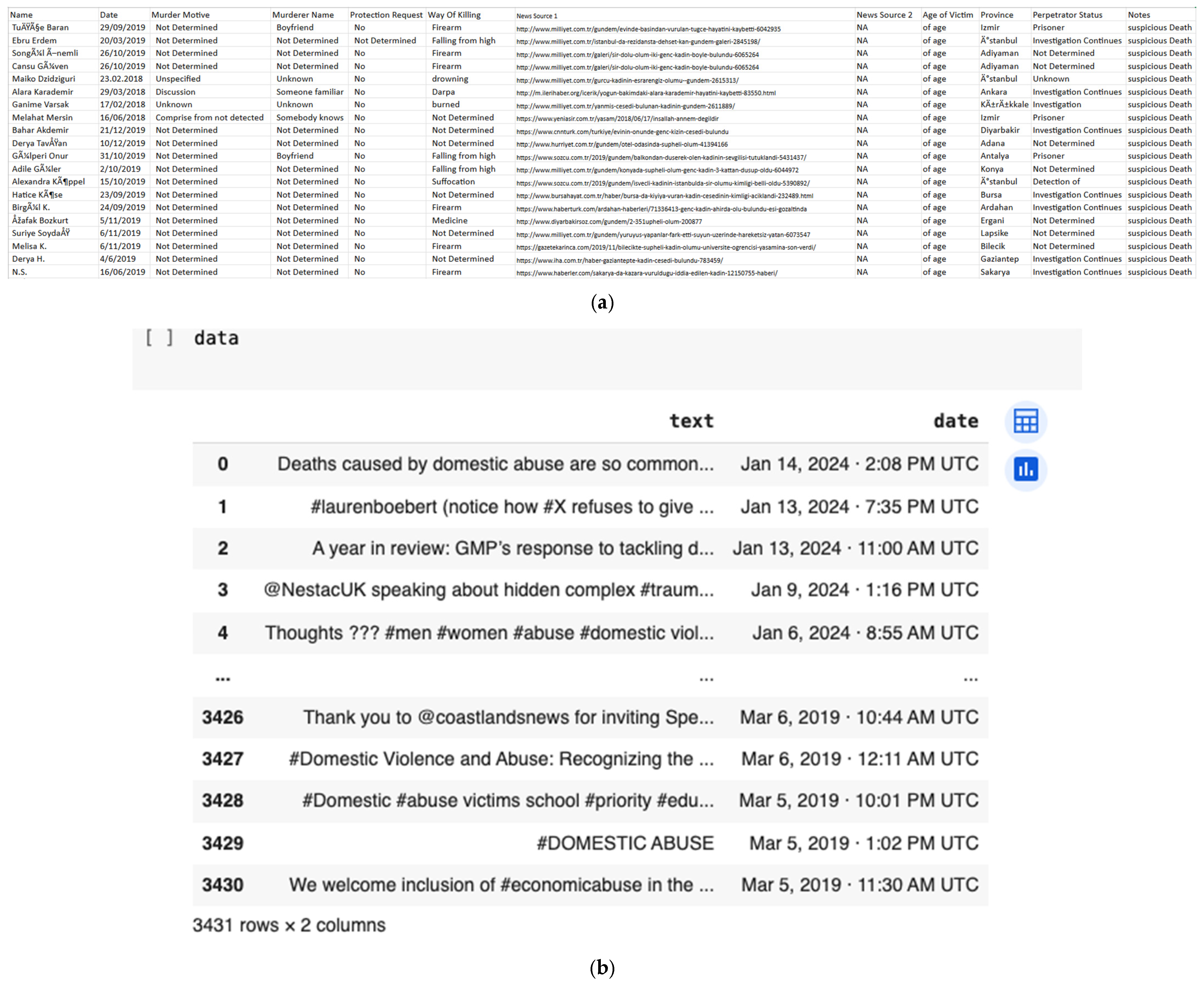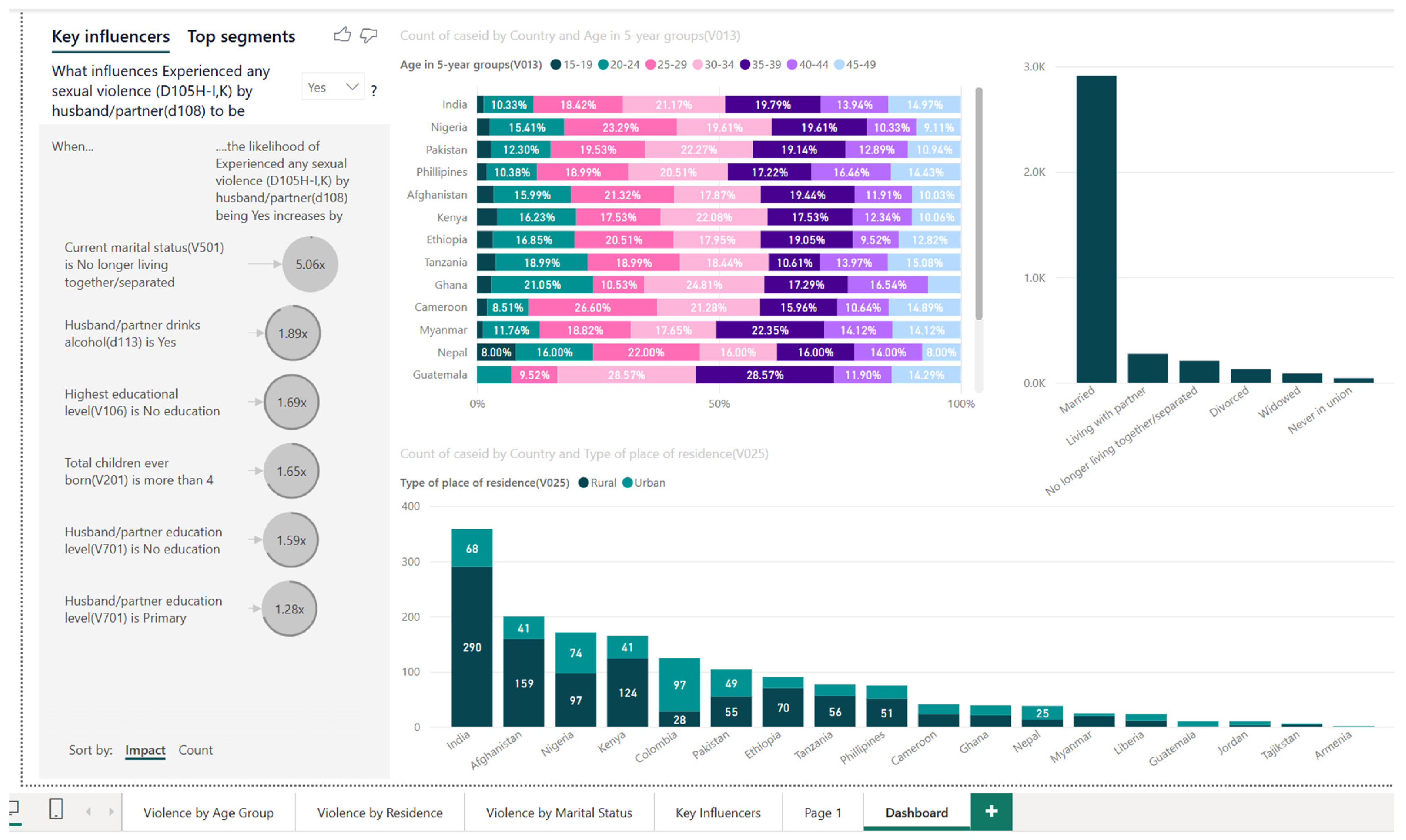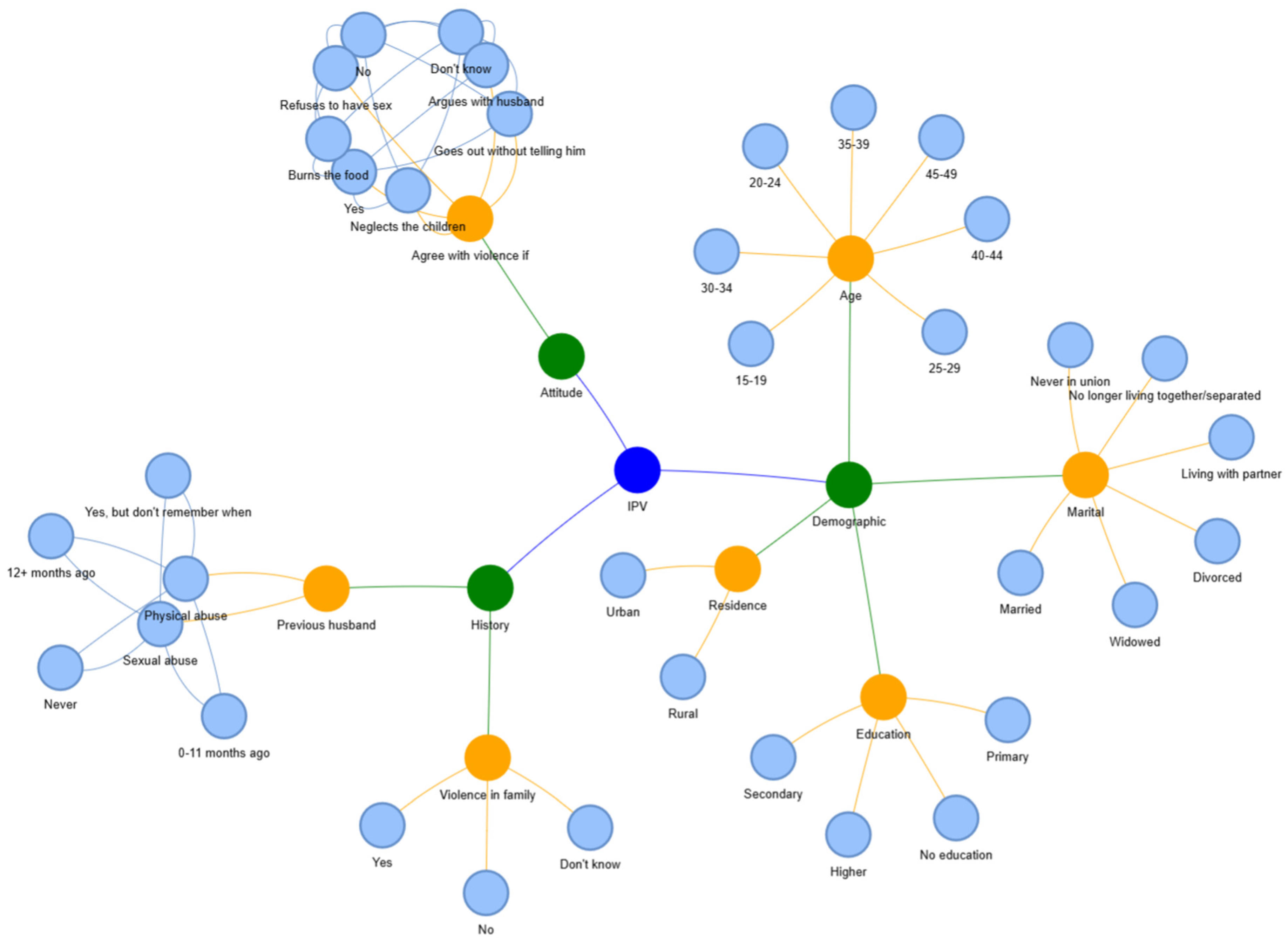Enhancing Gender-Based Violence Research: Holistic Approaches to Data Collection and Analysis
Abstract
1. Introduction
2. Related Work
3. Challenges in Data Selection and Tool Optimization
3.1. Exploration of Data Sources: Challenges, Comparison, and Selection Rationale
3.2. Tackling Dataset Challenges
3.3. Environment Challenges
3.4. Detecting and Addressing Data Inconsistencies Through Power BI
3.5. Visualization Through Network Graphs
4. Discussion
5. Conclusions
Author Contributions
Funding
Institutional Review Board Statement
Informed Consent Statement
Data Availability Statement
Acknowledgments
Conflicts of Interest
Abbreviations
| GBV | Gender-Based Violence |
| DHS | Demographic and Health Surveys |
| IPV | Intimate Partner Violence |
| USAID | United States Agency for International Development |
| EIGE | European Institute for Gender Equality |
| FRA | Fundamental Rights Agency |
| ONS | Office of National Statistics |
| CSEW | Crime Survey for England and Wales |
| LMICs | Low- and Middle-Income Countries |
References
- WHO. Violence Against Women. 25 March 2024. Available online: https://www.who.int/news-room/fact-sheets/detail/violence-against-women#:~:text=Estimates%20published%20by%20WHO%20indicate,violence%20is%20intimate%20partner%20violence (accessed on 15 April 2024).
- Eurostat. Every Woman Deserves to be Safe. But One in Three Women Still Experience Violence in the EU. 2024. Available online: https://eige.europa.eu/ (accessed on 25 November 2024).
- Gov.uk. Tackling Violence Against Women and Girls Strategy; Home Office: London, UK, 2021. [Google Scholar]
- USAID. In United States Agency for International Development; 2024. Available online: https://www.usaid.gov/ (accessed on 15 November 2024).
- Walby, S.; Towers, J. Measuring violence to end violence: Mainstreaming gender. J. Gender-Based Violence 2017, 1, 11–31. [Google Scholar] [CrossRef]
- Peterman, A.; Devries, K.; Guedes, A.; Chandan, J.S.; Minhas, S.; Lim, R.Q.H.; Gennari, F.; Bhatia, A. Ethical reporting of research on violence against women and children: A review of current practice and recommendations for future guidelines. BMJ Glob. Health 2023, 8, e011882. [Google Scholar] [CrossRef] [PubMed]
- Beyene, A.S.; Chojenta, C.; Roba, H.S.; Melka, A.S.; Loxton, D. Gender-based violence among female youths in educational institutions of Sub-Saharan Africa: A systematic review and meta-analysis. Syst. Rev. 2019, 8, 1–14. [Google Scholar] [CrossRef] [PubMed]
- Ostadtaghizadeh, A.; Zarei, M.; Saniee, N.; Rasouli, M.A. Gender-based violence against women during the COVID-19 pandemic: Recommendations for future. BMC Women’s Health 2023, 23, 219. [Google Scholar] [CrossRef] [PubMed]
- Division for the advancement of Women. Violence Against Women: A Statistical Overview, Challenges and Gaps in Data; Economic Commission for Europe and World Health Organization: Geneva, Switzerland, 2005. [Google Scholar]
- Fraga, S. Methodological and ethical challenges in violence research. Porto Biomed. J. 2016, 1, 77–80. [Google Scholar] [CrossRef] [PubMed]
- Patel, P. Synthetic data. Bus. Inf. Rev. 2024, 41, 48–52. [Google Scholar] [CrossRef]
- NewsFirst. NewsFirst. 2024. Available online: https://english.newsfirst.lk/ (accessed on 12 November 2024).
- UK Data Service. UK Data Service. 2024. Available online: https://ukdataservice.ac.uk/ (accessed on 29 October 2024).
- Dgraph Labs, Inc. Graphs and Networks for Beginners. 2024. Available online: https://dgraph.io/blog/post/graphs-and-networks/ (accessed on 22 October 2024).
- O’Brein, S.R.; Piay-Fernandez, N. Global Symposium on Technology-Facilitated Gender-Based Violence Results: Building a Common Pathway; Wilson Center: Washington, DC, USA, 2022. [Google Scholar]
- Vahedi, L.; Qushua, N.; Seff, I.; Doering, M.; Stoll, C.; Bartels, S.A.; Stark, L. Methodological and Ethical Implications of Using Remote Data Collection Tools to Measure Sexual and Reproductive Health and Gender-Based Violence Outcomes among Women and Girls in Humanitarian and Fragile Settings: A Mixed Methods Systematic Review of Peer-Reviewed Research. Natl. Libr. Med. Trauma Violence Abus. 2023, 24, 2498–2529. [Google Scholar] [CrossRef]
- Iyawa, G.E.; Akinmoyeje, B.A.; Kays, R.; Mutelo, S.; Ipinge, R. Women as Citizen Scientists: Identifying Potential Digital Solutions for Addressing Gender-Based Challenges. In Proceedings of the IST-Africa Conference, Virtual, South Africa, 10–14 May 2021; IEEE: Piscataway, NJ, USA, 2021. [Google Scholar]
- Stevens, L.M.; Bennett, T.C.; Cotton, J.; Rockowitz, S.; Flowe, H.D. A critical analysis of gender-based violence reporting and evidence building applications (GBVxTech) for capturing memory reports. Front. Psychol. 2024, 14, 1289817. [Google Scholar] [CrossRef] [PubMed]
- Bello, H.J.; Palomar-Ciria, N.; Gallego, E.; Navascués, L.J.; Lozano, C. Big Data Techniques to Study the Impact of Gender-Based Violence in the Spanish News Media. Central Eur. J. Commun. 2023, 16, 101–116. [Google Scholar] [CrossRef] [PubMed]
- Rodríguez-Rodríguez, I.; Rodríguez, J.-V.; Pardo-Quiles, D.-J.; Heras-González, P.; Chatzigiannakis, I. Modeling and Forecasting Gender-Based Violence through Machine Learning Techniques. Appl. Sci. 2020, 10, 8244. [Google Scholar] [CrossRef]
- Rahman, R.; Alam Khan, N.; Sara, S.S.; Rahman, A.; Khan, Z.I. A comparative study of machine learning algorithms for predicting domestic violence vulnerability in Liberian women. BMC Women’s Health 2023, 23, 542. [Google Scholar] [CrossRef] [PubMed]
- Shifidi, P.P.; Stanley, C.; Azeta, A.A. Machine Learning-Based Analytical Process for Predicting the Occurrence of Gender-Based Violence. In Proceedings of the 2023 International Conference on Emerging Trends in Networks and Computer Communications (ETNCC), Windhoek, Namibia, 16–18 August 2023; pp. 1–8. [Google Scholar]
- Hämäläinen, P.; Tavast, M.; Kunnari, A. Evaluating Large Language Models in Generating Synthetic HCI Research Data: A Case Study. In Proceedings of the CHI ‘23: CHI Conference on Human Factors in Computing Systems, Hamburg, Germany, 23–28 April 2023; pp. 1–19. [Google Scholar]







| S. No. | Types of Violence | 2019–2020 | 2020–2021 | 2021–2022 | 2022–2023 | 2023–2024 | Total |
|---|---|---|---|---|---|---|---|
| 1. | Rape | 2230 | 2144 | 2532 | 2380 | 2387 | 11,673 |
| 2. | Attempt to rape | 786 | 687 | 735 | 655 | 518 | 3381 |
| 3. | Polygamy | 1001 | 734 | 852 | 809 | 723 | 4119 |
| 4. | Child marriage | 86 | 64 | 84 | 52 | 52 | 338 |
| 5. | Accusations of witchcraft | 46 | 34 | 61 | 49 | 43 | 233 |
| 6. | Illegal abortion | 27 | 29 | 27 | 37 | 32 | 152 |
| 7. | Racial untouchability | 43 | 30 | 39 | 15 | 27 | 154 |
| 8. | Unnatural intercourse | 24 | 27 | 36 | 31 | 35 | 153 |
| 9. | Child sexual abuse | 211 | 232 | 281 | 314 | 343 | 1381 |
| 10. | Human trafficking | 15 | 1 | 10 | 23 | 10 | 59 |
| 11. | Abduction | 47 | 34 | 67 | 72 | 59 | 279 |
| 12. | Domestic violence | 14,774 | 11,738 | 14,232 | 17,000 | 16,519 | 74,263 |
| 13. | Acid attack | 0 | 0 | 6 | 4 | 3 | 13 |
| Total | 19,290 | 15,754 | 18,962 | 21,441 | 20,751 | 96,198 | |
| (a) | ||||||
| Name | Age | Abuse Inflicted | Relation to Victim | Lead to Death? | Country | Year |
| null | 61 | null | husband | Y | Sri Lanka | 2020 |
| Shyamila Swapana | 19 | set on fire | husband | Y | Sri Lanka | 2017 |
| null | 39 | raped, verbally abused | husband | N | Sri Lanka | started in 2005, fled to NZ in 2017 |
| null | 29 | killed using pole | husband | Y | Sri Lanka | 2021 |
| (b) | ||||||
| Name of Victim | Country | Type | Relation to Victim | Lead to Death | Date of Incident | info |
| null | Ireland | whipped | partner | N | null | null |
| null | United States | killed with hammer | husband | Y | null | null |
| Deborah Brandao | United States | stabbed | ex-boyfriend | Y | 18 April 2021 | null |
| null | Australia | house fire | son | Y | 7 January 2024 | null |
| Mandeep Kaur | United States | null | null | null | null | null |
| Data Source | Data Type | Challenges/Limitations | Decision/Action |
|---|---|---|---|
| Nepalese police records | Administrative crime statistics | Highly aggregated data; lack of granular victim/perpetrator details; limited access to sensitive cases | Used for preliminary exploration; insufficient for detailed GBV research |
| Open-source online datasets | Survey data from few countries | Sparse data; heavy missing values; inconsistent formats | Explored but found insufficient for reliable cross-country analysis |
| Synthetic data (generated) | Simulated data entries | Lacked real-world variability, noise, and authenticity crucial for modelling GBV patterns | Not used for final analysis due to limitations in validity |
| Web scraping—news websites | Crime reports from articles | Focused on extreme/high-profile cases; limited data volume; biased toward newsworthy events | Supplemented understanding; not used as primary dataset |
| Web scraping—Twitter data | Social media posts (#DomesticAbuse, #DomesticViolence, #MeToo) | Incomplete metadata; lack of verification; inconsistent and generalized information | Supplemented understanding; not suitable for further analysis |
| Demographic and Health Surveys (DHS) | Large-scale, standardized surveys | Comprehensive, structured, multi-country data on domestic violence with demographic variables | Selected for primary analysis due to high-quality, consistency across regions, and relevance to GBV research |
| Region | Country | DHS Phase | Year Selected | Years Available |
|---|---|---|---|---|
| Sub-Saharan Africa | Cameroon | 7 | 2018 | 1991, 1998, 2004, 2011, 2018 |
| Ethiopia | 7 | 2016 | 2000, 2005, 2011, 2016 | |
| Liberia | 7 | 2019–2020 | 1986, 2007, 2013, 2019–2020 | |
| Nigeria | 7 | 2018 | 1990, 2003, 2008, 2013, 2018 | |
| Ghana | 8 | 2022 | 1988, 1993, 1998, 2003, 2008, 2014, 2022 | |
| Kenya | 8 | 2022 | 1989, 1993, 1998, 2003, 2008–2009, 2014, 2022 | |
| Tanzania | 8 | 2022 | 1991–1992, 1996, 1999, 2004–2005, 2010, 2015–2016, 2022 | |
| Latin America and Caribbean | Colombia | 7 | 2015 | 1986, 1990, 1995, 2000, 2005, 2010, 2015 |
| Guatemala | 7 | 2014–2015 | 1987, 1995, 2014–2015 | |
| North Africa, West Asia, Europe | Albania | 7 | 2017–2018 | 2008–2009, 2017–2018 |
| Turkey | 7 | 2018 | 1993, 1998, 2003, 2008, 2013, 2018 | |
| Armenia | 7 | 2015–2016 | 2015, 2016 | |
| Jordan | 7 | 2017–2018 | 2017, 2018 | |
| Central Asia | Tajikistan | 7 | 2017 | 2012, 2017 |
| South and Southeast Asia | Afghanistan | 7 | 2015 | 2015 |
| Bangladesh | 7 | 2017–2018 | 1993–1994, 1996–1997, 1999–2000, 2004, 2007, 2011, 2014, 2017–2018 | |
| India | 7 | 2019–2021 | 1992–1993, 1998–1999, 2005–2006, 2015–2016, 2019–2021 | |
| Myanmar | 7 | 2015–16 | 2015–16 | |
| Pakistan | 7 | 2017–18 | 1990–91, 2006–07, 2012–13, 2017–18 | |
| Philippines | 7 | 2017 | 2017 | |
| Nepal | 7 | 2015 | 2015 |
Disclaimer/Publisher’s Note: The statements, opinions and data contained in all publications are solely those of the individual author(s) and contributor(s) and not of MDPI and/or the editor(s). MDPI and/or the editor(s) disclaim responsibility for any injury to people or property resulting from any ideas, methods, instructions or products referred to in the content. |
© 2025 by the authors. Licensee MDPI, Basel, Switzerland. This article is an open access article distributed under the terms and conditions of the Creative Commons Attribution (CC BY) license (https://creativecommons.org/licenses/by/4.0/).
Share and Cite
Shrestha, S.; Patel, P.; Longchar, S.; Xavier, A.F. Enhancing Gender-Based Violence Research: Holistic Approaches to Data Collection and Analysis. Women 2025, 5, 19. https://doi.org/10.3390/women5020019
Shrestha S, Patel P, Longchar S, Xavier AF. Enhancing Gender-Based Violence Research: Holistic Approaches to Data Collection and Analysis. Women. 2025; 5(2):19. https://doi.org/10.3390/women5020019
Chicago/Turabian StyleShrestha, Subeksha, Preeti Patel, Sentirenla Longchar, and Aiswarya Francis Xavier. 2025. "Enhancing Gender-Based Violence Research: Holistic Approaches to Data Collection and Analysis" Women 5, no. 2: 19. https://doi.org/10.3390/women5020019
APA StyleShrestha, S., Patel, P., Longchar, S., & Xavier, A. F. (2025). Enhancing Gender-Based Violence Research: Holistic Approaches to Data Collection and Analysis. Women, 5(2), 19. https://doi.org/10.3390/women5020019






